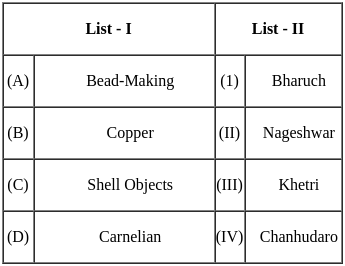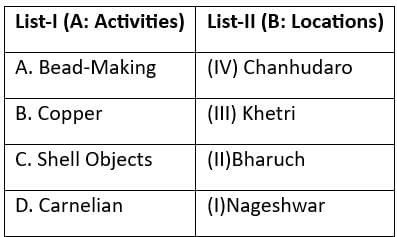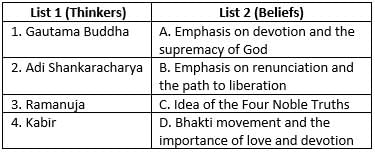History: CUET Mock Test - 2 - CUET MCQ
30 Questions MCQ Test - History: CUET Mock Test - 2
Which of the following is not the outcome of the Swadeshi Movement?
In which of the following years did Mahatma Gandhi represent India in the Second Round Table Conference to discuss constitutional reform in India?
The Sanchi Stupa, a prominent historical monument related to Buddhism, was commissioned by which Mauryan emperor?
The terracotta models of plough have been found at which site?
The site of shortughai in Afganistan sources which material for craft production?
Arrange the following developments of 'Harrapan Archaeology' in chronological order:
(A) S.R. Rao begins excavations at Lothal.
(B) R.S. Bisht begins excavations at Dholviara.
(C) B.B. Lal excavates at Kalibangan.
(D) R.E.M. Wheeler excavates at Harappa.
(E) M.S. Vats begins excavations at Harappa.
Choose the correct answer from the options given below:
Identify the statements which are 'true' for Harrapan Civilisation.
(A) Animals were not domesticated in Harrapan culture.
(B) Evidence of ploughed field have been found at Kalibangan.
(C) Traces of canals have been found in Punjab and Sind.
(D) Water reservoirs have been found in Dholavira.
(E) Mohenjodaro has been identified as planned Urban Centre.
Choose the correct answer from the options given below:
Match List - I with List - II.

Choose the correct answer from the options given below:
What was the primary duty of the Brahmanas according to the Dharmashastras?
Which varna was responsible for trade and agriculture?
What does the term 'endogamy' refer to in the context of ancient Indian marriage rules?
Why were the Dharmashastras considered important for social order?
During which period were the Dharmasutras and Dharmashastras composed?
Villages whose headmen and cultivators were mobilised against the British rule by Shah Mal were
How many sessions of the constituent Assembly were held?
Shaikh Nizamuddin’s hospice comprised several small rooms and a big hall known as
How many avatars of Vishnu were identified by the Vaishnavas?
What was the name of the gana to which Buddha belonged?
_____ coins were more prevalent during the Mughal Empire.
Identify which of the metal was used more often to makemohur coins during the Mughal Empire?
What did the expansion of the peasant economy create in the Rajmahal hills?
Who traveled through the Rajmahal Hills in the early nineteenth century?
Where was Gandhiji involved in two campaigns in 1918?
Mahatma Gandhi wanted to make ____ language as the national language.





















